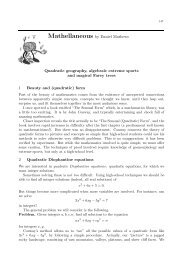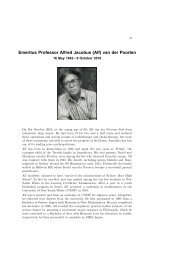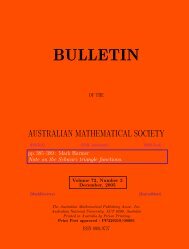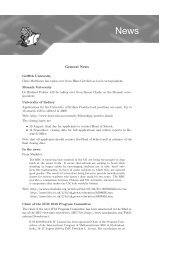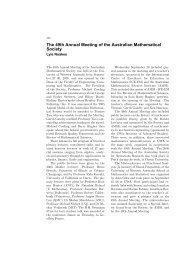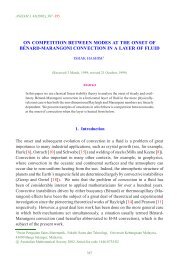FIBONACCI - HIS RABBITS AND HIS NUMBERS and KEPLER
FIBONACCI - HIS RABBITS AND HIS NUMBERS and KEPLER
FIBONACCI - HIS RABBITS AND HIS NUMBERS and KEPLER
You also want an ePaper? Increase the reach of your titles
YUMPU automatically turns print PDFs into web optimized ePapers that Google loves.
has an odd subscript (first proved by Lucas in 1876)<br />
(Fn) 2 +(Fn+1) 2 = F2n+1.<br />
Now form a sequence made up of the squares of the terms then, from this form a new<br />
sequence made up of the sums of consecutive squares. It follows from our relationship that<br />
this new sequence will be the same as the sequence of terms with odd subscripts.<br />
P6. For any four consecutive terms A,B,C,D : C 2 − B 2 = AD.<br />
P7. With the exception of 3, every term that is prime has a prime subscript (thus 233<br />
is prime <strong>and</strong> has a prime subscript 13). However be warned that the converse does not hold:<br />
a prime subscript does not mean that the the term is prime. Our first counter example does<br />
not occur until F19 =4, 181 where although 19 is prime<br />
4,181 = 37 times 113 <strong>and</strong> is thus composite.<br />
In fact if the converse held it would tell us that the number of terms which are prime is<br />
infinite. As it is we just do not know how many terms are prime. That is we just do not<br />
know whether a largest prime Fibonacci number exists. This is one of the many unsolved<br />
Fibonacci problems.<br />
P8. It was only recently proved that F12 = 144, is the only term (apart from the trivial<br />
case of 1) which is a square. Surprisingly it also happens to be the square of its subscript.<br />
P9. For every integer i there are an infinite number of terms that can be divided by i <strong>and</strong><br />
at least one can be found amongst the first i 2 terms.<br />
P10. The sum of the first n terms is one less than a Fibonacci number. In fact the sum of<br />
the first n terms is Fn+2 − 1. (Again this result is due to Lucas).<br />
P11. If we exp<strong>and</strong> G(z) =1/(1 − z − z 2 ) as a power series in z we obtain<br />
F1 + F2z + F3z 2 + F4z 3 + ...+ Fiz i−1 + ...<br />
That is the coefficient of z i−1 generates the ith Fibonacci number <strong>and</strong> hence G(z) is the<br />
generating function for the Fibonacci numbers.<br />
This is readily checked. Multiply the power series succesively by 1, −z, <strong>and</strong> −z 2 , regroup<br />
the terms <strong>and</strong> everything else cancels out leaving 1.<br />
P12. We note that the reciprocal of F11 =89, can be written in the following curious<br />
way. Start with .0 then add the first term obtaining .01 then add the next term obtaining .011<br />
<strong>and</strong> so on from which<br />
.0112358<br />
8





